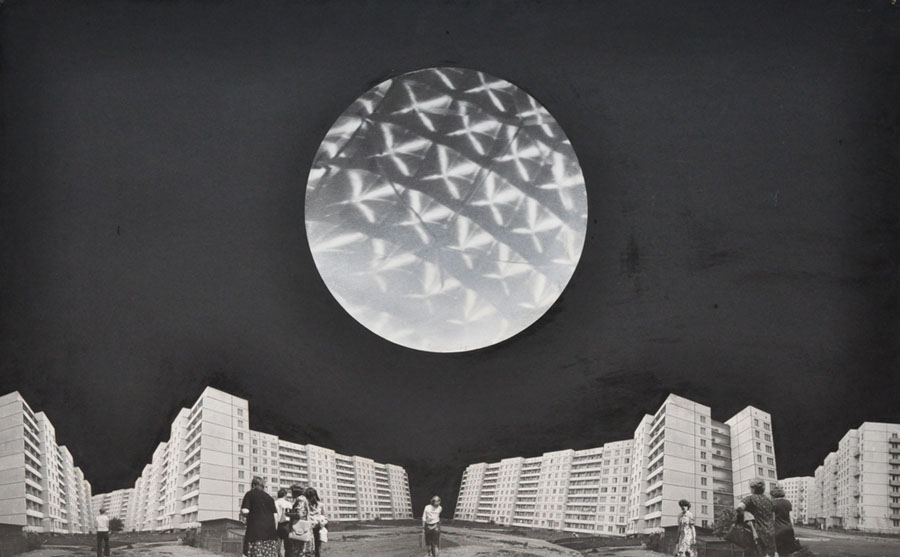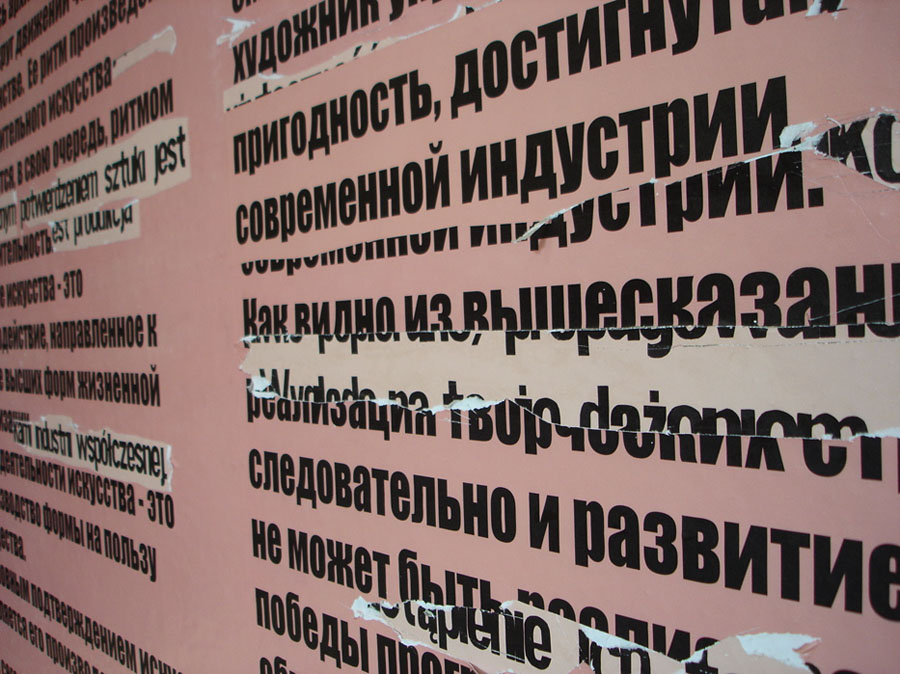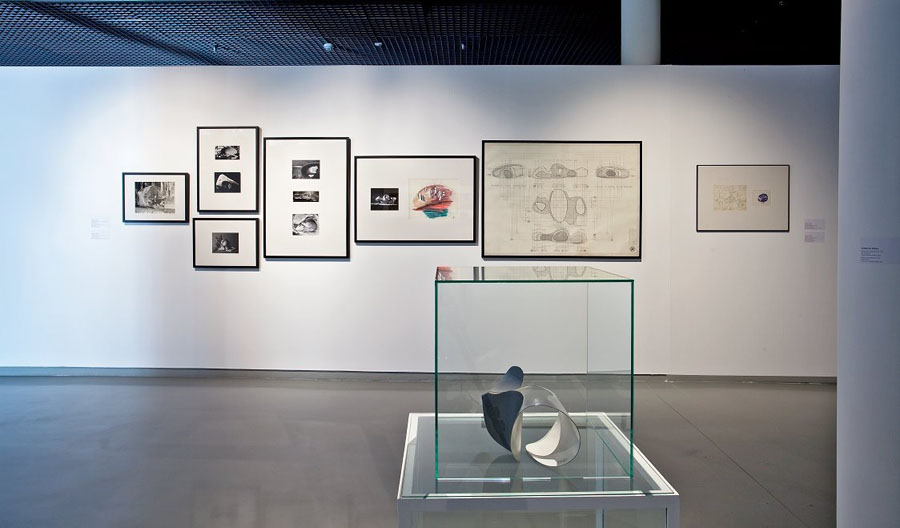Eyes Looking For a Head to Inhabit in Łódź (Exhibition Review)
Eyes Looking For a Head to Inhabit, curated by Aleksandra Jach, Joanna Soko?owska, Katarzyna S?oboda and Magdalena Zió?kowska, Museum of Art ?ód?, 30 September, 2011-11 December, 2011.

The exhibition at the Museum of Art in ?ód? celebrates the 80th anniversary of the International Collection of Modern Art, which was created by members of the Polish constructivist avantgarde: Katarzyna Kobro and W?adys?aw Strzemi?ski, with the effective help of Jan Brz?kowski and Henryk Sta?ewski, who together constituted the “a.r.” (revolutionary artists) group. This historical collection, encompassing a variety of contemporary artists’ works ranging from van Doesburg, through Leger, to Arp and Ernst, from cubism to surrealism, was the symbolic beginning of the presently existing Museum. In the 1930s it was one of the first modern art museums in the world, established mainly as a result of exchanges between artists as well as donations. Today the original collection is not only part of a much larger collection of exhibits, but a symbol of its significant legacy, marking its identity as the “institution of the avantgarde.”(For a broader historical reflection on this institutional identity, see: Andrzej Turowski, “Muzeum – instytucja awangardy”, Awangardowe marginesy, Warszawa 1998.)

Opening a collection of modern abstract art in 1931 in ?ód?, an industrial city in the center of Poland, meant finding a temporary home for the utopian endeavours that fed on avantgarde cosmopolitism and visions of modernization. Strzemi?ski, who was the main inspirer of this collection, had previously been acquainted with the new kind of art museums that avantgarde artists in Russia had organized after the Revolution. After 1922, the year he left Russia for his native Poland, among his many artistic, organizational and educational activities, Strzemi?ski dreamed of creating a similar collection of contemporary art, which would become a live embodiment of artists’ ideas, a tool for changing minds and constructing the future. This dream appeared to have come to fulfillment in 1931, when the municipality of ?ód? formally welcomed the “a.r.” group’s gift and the International Collection of Modern Art was exposed to public viewing in the Municipal Museum of History and Art in ?ód?. This happy event was both the effect of artists’ generosity and the openness of administrating leftist officials. However, this did not mean an immediate acceptance of Strzemi?ski’s ideas – for the majority of the public at the time, modern art still remained completely “outlandish”, burdened with the unfavorable associations of “bolshevism” and communism. The new museum exhibition was barely mentioned in the local press. Despite their wider recognition in international avantgarde circles, Strzemi?ski and Kobro remained isolated in their efforts and marginalized on the local artistic scene.
This sense of “isolation”, which became bitterly apparent in the history of the ?ód? Avantgarde, is to some extent still a worry for art institutions. Eyes Looking for a Head to Inhabit approaches this fact openly, but in a way that is also humorous and inviting. The show’s title may be read as a punning metaphor of the modern artist’s social and cultural position as an outsider and visionary, searching for a new community and trying to find a ground for his ideas. More specifically, the lonely “eyes” may be a cunning reference to Strzemi?ski’s Theory of Vision and his concept of “visual consciousness,” which implied that developing possibilities of seeing and conceiving steadily open humanity’s way to the future. Besides this reference to the avantgarde’s leadership, the title strikingly signalizes a quasi-surreal disorientation resulting from a gap between our physical, bodily understanding and new counterintuitive interpretations of the world as supplied by the modern sciences. Modern physics and new technologies changed the conditions we live in to such an extent that “»true reality,« the physical world, has receded entirely from the range of human senses.”(Hannah Arendt, “The Conquest of Space and the Stature of Man” (1963), Between Past and Future. Eight Exercises in Political Thought, New York, 1968. [http://www.thenewatlantis.com/publications/the-conquest-of-space-and-the-stature-of-man; date of entry: 23-11-2011].) Modern art also had its part in turning the world upside down and putting it in reverse. By placing avantgarde projects and experiments within a broader frame of reference, the exhibition goes beyond questioning their specific artistic traditions, and focuses instead on the twentieth-century futurist imagination – the artistic expressions and reflexes of “the age of man’s detachment from the world” (Odo Marquard). Bold cosmic phantasies that were a part of the avantgarde frame of mind, visions of modern architecture and design go side by side with “an-architectural” and performative practices, which offer more contemporary revisions and re-workings of modern projects. In Eyes Looking for a Head to Inhabit they come together as various proposals for modern cosmopolitics – all related to the question of how to inhabit modern space – mentally, physically and socially.

The tripartite structure of the exhibition traces the collection’s historical migration from one place to another: from the classicist town hall (the Municipal Museum of History and Art, where the “a.r.” collection was primarily held) to the Pozna?ski Palace (where it was placed after the war) and finally, in 2005, to the newly adapted building at Ogrodowa Street. In each site one may find some interwoven references to the patronal figures of Strzemi?ski and Kobro and their work, but by no means did the curators attempt to reconstruct the past. By going back to the original place – the former Municipal Museum, which is now the State Archive – they exposed viewers to the site where the collection was housed at the beginning. At the same time, people who visit this place for other professional or bureaucratic reasons may be surprised to find a visual narrative there, commenting on Strzemi?ski’s theories and other art pieces installed in the hall. These small interventions remind us of the building’s changing historical functions and the visible tension between the world it represented, on the one hand, and the radical modernity that arrived here in 1931 with avantgarde art, on the other. The intertwining issue of migration and modernization – which is strongly inscribed into the multinational past of the city – is also evoked in the works presented: in Josef Dabernig’s film Jogging (2000) we see a man in his car driving on a highway without aim, passing empty spaces and overly large modern constructions that clash with equally unreal remnants of rural life. In Ruth Oppenheim’s Three Suitcase Stories (2006) the meeting of East and West is metaphorically rendered in a dreamlike, fairytale atmosphere, though not without some bitter accents. In her second video-fantasy, Going Home, we are reminded of a feeling of strangeness that finding one’s original homeland may bring. ????? ?????? ? ??????????? ???? – ??? ??? ????? ??? ????????.

The topic of migration finds a more specific continuation in Jadwiga Sawicka’s work dedicated to Katarzyna Kobro. In her ms² installation Sawicka uses Kobro’s 1937 manifesto, a fervent polemic against the popular trends in national Polish sculpture. The text can be seen and heard in two languages – Polish and Russian, which are repeated, collaged together and partially eclipsed by one another.

This interference of voices and words reminds us that Kobro’s first language was Russian; in Poland, being able to assimilate in a milieu that was culturally alien and often inhospitable was a great endeavor. In Sawicka’s rewriting, Kobro’s motto: VICTORY of the intellect’s active forces over the state of irrationalism and CHAOS, applied to her unistic conception of “spatial composition,” assumes new emotional meanings and suggests an inner struggle behind the perceptible layer of rational control. Beyond the usual unitary identification of Katarzyna Kobro as a member of the Polish, or international, avantgarde, looms an identity that seems much more compounded and fractured.
In the main exhibition space by the entrance, together with ?ukasz Sk?pski’s Glasses for Looking Into the Sky and a 1982 reconstruction of the 1913 Futurist opera Victory over the Sun, our eyes and minds are lifted out of the gravitational field of the earth into cosmic space. The famous work by Kruchenykh, Matiushin, and Malevich opens up a narrative of the twentieth-century conquest of space and future technological improvements that could replace the natural environment. With all their utopian overtones, however, those visions appear to be far from simple pragmatic optimism: in Victory‘s grotesque performance, the Futurist pathos already mingles with the anxiety of catastrophe. In the 1960s and ‘70s, for artists coming from the Eastern Bloc – Julius Koller with his conceptual project U.F.O. (Universal Futuristic Operation); or Stano Filko’s Future Exploration of the Universe — the turn towards other possible worlds expressed, above all the artists’ subjective detachment from the hardening, oppressive reality in which they lived. Dreaming of other, extraterrestrial spaces – which seemed already to be within man’s reach – offered a point of view from which the existent political barriers could be virtually suspended and made relative. The new cosmic explorations were enthusiastically welcomed; in the background, however, we are reminded of the political circumstances around those triumphant conquests as a part of the global battle for power during the cold war.


On the other side of the iron curtain, in the context of the technological revolution that came in the decades after the war, one may observe a rising perception of the world as a totalized plastic organism. The new sense of cosmic forces, which –contrary to what Walter Benjamin had predicted(Walter Benjamin, “One-Way Street”, Selected Writings, vol. 1, ed. by Michael Jennings and Marcus Bullock, Harvard University Press, Cambridge, Mass., London, 1996, p. 486-487.) – did not vanish in modern times, but was revived again with the findings of modern physics and new powerful technologies. This new global vision is relevant in Le Corbusier’s manifesto of architectonic “humanism” (Poème électronique, 1958) presented as a universal antidote against the barbarism of war. Even more strikingly, this sense of omnipresent vitalism is expressed in subversive urban and architectural visions of the 1960s, as well as in the biomorphic forms of Frederic Kiesler’s Unfinished House. Fantastic constructions of Haus-Rucker-Co’s new homes, and technical apparatuses for regulating and transforming one’s perception of the environment appear today both as a record of extreme technological optimism and an echo of the fears of the atomic age. In series of works, such as Gustav Metzger’s Mobil or Matta-Clark’s Dancing in the Threes, the viewer may find the early manifestations of a new ecological consciousness, which demanded to renounce the traditional anthropocentric point of view. The harmonious reconciliation of elementary natural forces and human technologies finds a playful manifestation in Vadim Fiškin’s Kaplegaf (2005). Computer technologies and natural processes are meticulously orchestrated here to create a “multimedia” spectacle – a combination of spatial drawing and a musical concerto – in which the central role is played by falling and splashing water drops. Technical appliances become here a part of the “natural” multiplicity of free, active forces, much like in Cage and Cunningham’s choreographic Variations (1965) where the entire space comes to resonate with the sounds produced by the dancers’ movements, amplified by electroacoustic appliances.



The curators of the exhibition and the artists rightly recognize the potentially oppressive side of modern utopian projects and the way in which comprehensive systems structure the world they once proposed. Since the rise of postmodern critique, we have realized that the modern longing for rational order is ambiguously close to totalitarian control. In the final section of the exhibition this ominous association may be fully experienced in Nikita Kagan’s Procedure Room, a series of decorated plates that make a double reference to the constructivist tradition and to the disciplinary methods applied by the communist state. In Anna Orlikowska’s architectonic models, bearing a mimetic resemblance to Kobro’s spatial constructions, one can observe how spatial openness may be unnoticeably transformed into threatening closure. Nevertheless, in the exhibition’s polyphonic narrative there is also another, more optimistic vision of the avantgarde legacy, one which is closer to the body and to John Cage’s principles. Ultimately, it is by no means utterly unthinkable to see Strzemi?ski’s and Kobro’s visions of structuring space – based on their principles of unity and equality – enter into logical proximity with the structuring rhythms of dance and music. Dancing can unite people and give them, as Adrian Piper argues in Funk Lessons, “an exhilarating experience of going beyond one’s self,” it offers a form of concord without subordination, a provisional community that allows for differences. The utopian aspirations of the avantgarde may seem minimized by suggesting this kind of connection, but they are still kept as an authentic proposition for the future (cosmic) community. In the meantime, this exhibition – without even a hint of didacticism – offers us samples of utopia, with the artists’ works supplying us with sensitive “eyes” that may be helpful for finding a new sense of our position in space.




